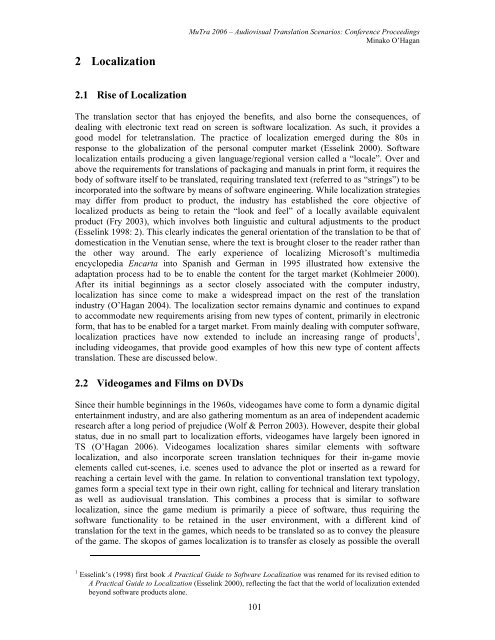Proceedings - Translation Concepts
Proceedings - Translation Concepts
Proceedings - Translation Concepts
You also want an ePaper? Increase the reach of your titles
YUMPU automatically turns print PDFs into web optimized ePapers that Google loves.
MuTra 2006 – Audiovisual <strong>Translation</strong> Scenarios: Conference <strong>Proceedings</strong><br />
Minako O’Hagan<br />
2 Localization<br />
2.1 Rise of Localization<br />
The translation sector that has enjoyed the benefits, and also borne the consequences, of<br />
dealing with electronic text read on screen is software localization. As such, it provides a<br />
good model for teletranslation. The practice of localization emerged during the 80s in<br />
response to the globalization of the personal computer market (Esselink 2000). Software<br />
localization entails producing a given language/regional version called a “locale”. Over and<br />
above the requirements for translations of packaging and manuals in print form, it requires the<br />
body of software itself to be translated, requiring translated text (referred to as “strings”) to be<br />
incorporated into the software by means of software engineering. While localization strategies<br />
may differ from product to product, the industry has established the core objective of<br />
localized products as being to retain the “look and feel” of a locally available equivalent<br />
product (Fry 2003), which involves both linguistic and cultural adjustments to the product<br />
(Esselink 1998: 2). This clearly indicates the general orientation of the translation to be that of<br />
domestication in the Venutian sense, where the text is brought closer to the reader rather than<br />
the other way around. The early experience of localizing Microsoft’s multimedia<br />
encyclopedia Encarta into Spanish and German in 1995 illustrated how extensive the<br />
adaptation process had to be to enable the content for the target market (Kohlmeier 2000).<br />
After its initial beginnings as a sector closely associated with the computer industry,<br />
localization has since come to make a widespread impact on the rest of the translation<br />
industry (O’Hagan 2004). The localization sector remains dynamic and continues to expand<br />
to accommodate new requirements arising from new types of content, primarily in electronic<br />
form, that has to be enabled for a target market. From mainly dealing with computer software,<br />
localization practices have now extended to include an increasing range of products 1 ,<br />
including videogames, that provide good examples of how this new type of content affects<br />
translation. These are discussed below.<br />
2.2 Videogames and Films on DVDs<br />
Since their humble beginnings in the 1960s, videogames have come to form a dynamic digital<br />
entertainment industry, and are also gathering momentum as an area of independent academic<br />
research after a long period of prejudice (Wolf & Perron 2003). However, despite their global<br />
status, due in no small part to localization efforts, videogames have largely been ignored in<br />
TS (O’Hagan 2006). Videogames localization shares similar elements with software<br />
localization, and also incorporate screen translation techniques for their in-game movie<br />
elements called cut-scenes, i.e. scenes used to advance the plot or inserted as a reward for<br />
reaching a certain level with the game. In relation to conventional translation text typology,<br />
games form a special text type in their own right, calling for technical and literary translation<br />
as well as audiovisual translation. This combines a process that is similar to software<br />
localization, since the game medium is primarily a piece of software, thus requiring the<br />
software functionality to be retained in the user environment, with a different kind of<br />
translation for the text in the games, which needs to be translated so as to convey the pleasure<br />
of the game. The skopos of games localization is to transfer as closely as possible the overall<br />
1 Esselink’s (1998) first book A Practical Guide to Software Localization was renamed for its revised edition to<br />
A Practical Guide to Localization (Esselink 2000), reflecting the fact that the world of localization extended<br />
beyond software products alone.<br />
101
















